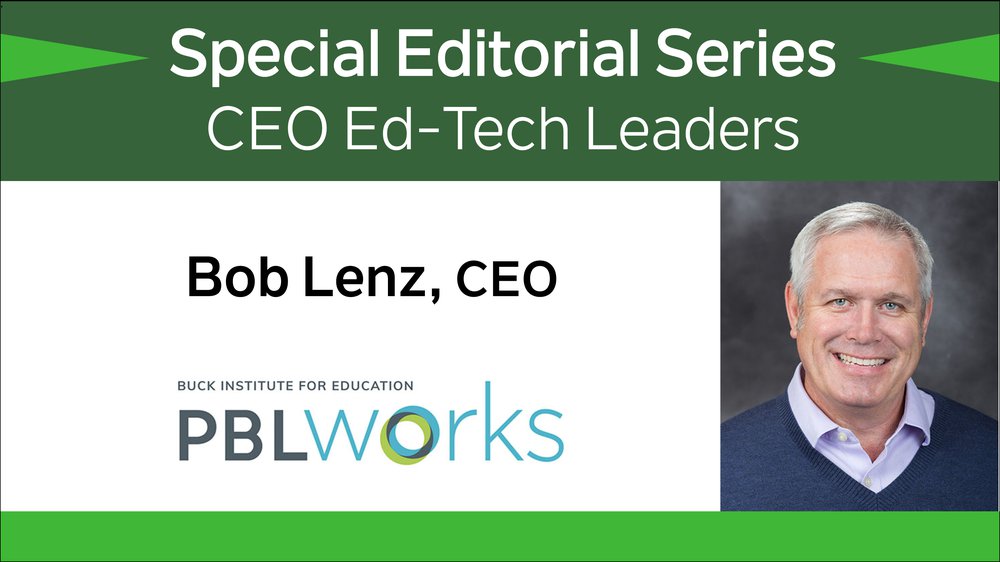Bob Lenz became CEO of Buck Institute for Education PBLWorks in 2015. Before taking on his role at PBLWorks, his familiarity with Project Based Learning (PBL) matured as the co-founder of Envision Education and served as its CEO and Chief of Innovation. During Lenz's leadership, Envision Education won several awards by implementing an innovative model that effectively created a path to college and college retention for underserved urban students at Envision’s three Bay Area arts and technology high schools. He recently authored Transforming Schools: Using Project-Based Learning, Performance Assessment and Common Core Standards.
PBLWorks provides resources, training, and support to help schools, districts and teachers implement PBL in the classroom with the intent that students become successful in the world outside of school while engaging students in authentic intellectually challenging work at school. "The modern workplace is increasingly project-based, and people need to be able to work well in teams, solve complex problems, and communicate ideas," explains Lenz. "PBL is a teaching method that does this – and it also helps students retain academic knowledge and skills."
“Too often, our school system reverts to the methods of the past to teach students the skills they need for tomorrow. Rote memorization and the ‘sit and get’ approach no longer work," explains Lenz. "We see too many students who find schooling to be meaningless – even high-achievers are often just playing the game and are not deeply engaged by schoolwork. There’s a lack of connection between school and the real world and an over-emphasis on testing fact-based knowledge as opposed to deeper understanding and success skills."
PBLWorks is designed to challenge and engage students. "Implementing high-quality PBL as a regular practice across a school requires a shift in the way schools operate, and a concerted, organized, sustained effort by all levels of school personnel,” says Lenz.
A University of California, Berkeley graduate, Yvonne Armenta story demonstrates how PBL guides students toward a successful outcome. She was the first in her family to graduate from high school and attend college. Yvonne shared her experiences with PBL in high school, “Engaging students in meaningful projects that not only encourage them to seek answers to questions they are passionate about but later allowing them to creatively prove that they have retained the necessary knowledge… creates self-confidence, agency, and clear vision of who they are as students.”
She credits her accomplishments to her experiences with PBL and her portfolio defense, a collection of her work as evidence of her achievements told as a story of her learning journey. "This sense of agency propelled her through college, where she was able to handle any problem she faced, work in teams, make presentations, and advocate for herself. She was not a passive learner, as many students are as they sit quietly taking lecture notes and memorizing for exams," describes Lenz.
Lenz says teachers have to believe in the potential of PBL, design and adopt good projects, and work with their students to make the project succeed. Majority of teachers never received training on PBL when they were earning their teaching credential, nor did they experience PBL when they were in school. For that reason, teachers are not familiar with PBL, and they teach in the traditional way they learned in school. “This makes changing teacher practice difficult, so we provide the best possible professional development and then ongoing support over a period of years.”
Getting teachers to change their way of teaching is not easy. PBLWorks strives to help the teachers get a mental model of teaching PBL. They provide development and ongoing support. “We work with school and district leaders, who create the conditions needed for teachers to use PBL effectively. For example, they find more planning time for teachers, increase the length of class periods in middle and high school, and ease up on the pressure to 'cover content' for standardized testing,” explains Lenz.
Students need to be willing to work in new ways they may not be comfortable with at first. Instead of memorizing information in a project, they’re taught to ask questions, work in teams, create products to demonstrate their learning, and share them publicly.
It’s crucial parents know about the PBL implementation effort. They are probably unfamiliar with PBL and would need information about it. "If their child is already successful in school, they might wonder why there is a need to change to PBL," explains Lenz. “But once parents see the benefits of PBL for their child, they’re sold on the idea. They also appreciate being able to see student presentations and can contribute their expertise to projects.”
One of the biggest myths and challenges in implementing high-quality PBL is that teachers believe they don’t have time for projects. PBLWorks shows districts how teaching a concept through a project is the most efficient way to help students learn the material. If a teacher teaches the concept, students may not retain it. But if they use PBL to go deeper, students learn how to apply the concept. “They will retain a math lesson much better if they are using those concepts to design a house for a real client or using a science lesson to come up with solutions to the pollution problem plaguing the body of water near their school,” clarifies Lenz “One of our favorite sayings is that PBL is the main course, not dessert.”
“Through PBL, teachers can teach multiple concepts and facilitate deep learning with just one project, making it a highly effective method of instruction. When we work with schools, our model helps teachers build-in the time to plan and execute a project to ensure its success. PBL doesn’t have to be done all the time to have an impact. The goal should be a minimum of two high-quality PBL projects every year in every classroom.”
Though PBL doesn’t require extensive educational technology, PBLWorks recently implemented a platform to share a free online library of 60 downloadable Project Idea Cards. Teachers developed the projects and tested them in the classroom. “By offering ideas for high-quality projects, we hope to help and inspire teachers to get started with or grow their use of PBL in the classroom. Each project represents an authentic challenge, and student work is structured to promote academic mastery and development of 21st-century success skills such as critical thinking and teamwork,” explains Lenz. “PBL can be transformative for students, especially those furthest from educational opportunity. We think PBL works for all students, all grade levels, all subjects. Now more than ever, we need young people who are ready, willing, and able to tackle the challenges of their lives and the world they will inherit - and nothing prepares them better than Project Based Learning.”











